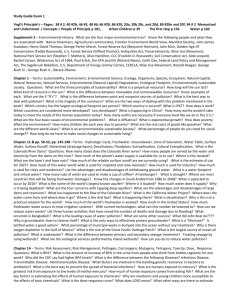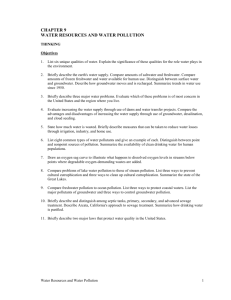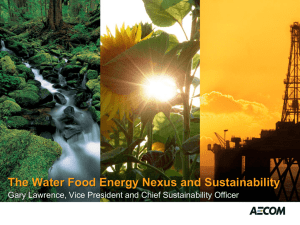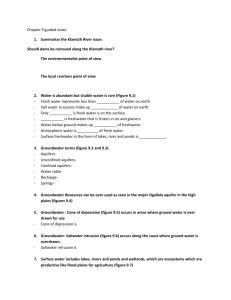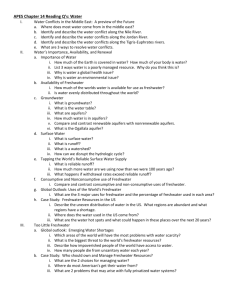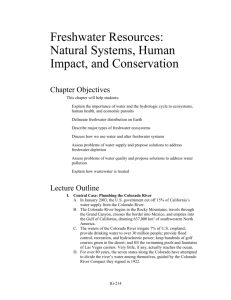Freshwater Resources Outline - Lakeland Regional High School
advertisement
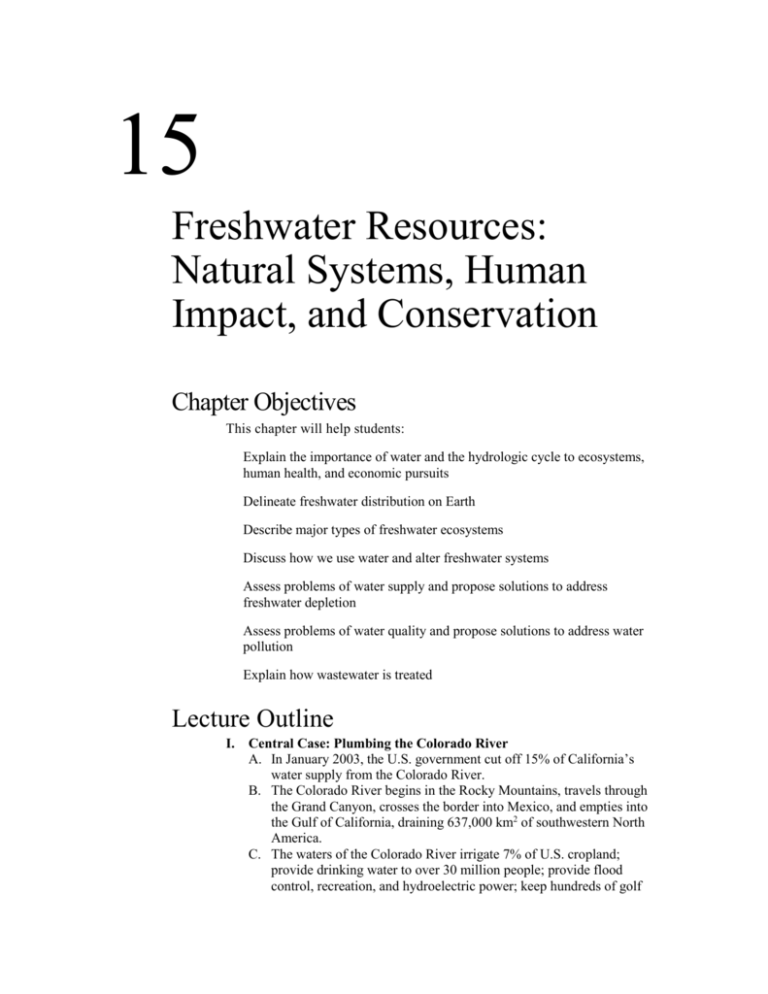
15 Freshwater Resources: Natural Systems, Human Impact, and Conservation Chapter Objectives This chapter will help students: Explain the importance of water and the hydrologic cycle to ecosystems, human health, and economic pursuits Delineate freshwater distribution on Earth Describe major types of freshwater ecosystems Discuss how we use water and alter freshwater systems Assess problems of water supply and propose solutions to address freshwater depletion Assess problems of water quality and propose solutions to address water pollution Explain how wastewater is treated Lecture Outline I. Central Case: Plumbing the Colorado River A. In January 2003, the U.S. government cut off 15% of California’s water supply from the Colorado River. B. The Colorado River begins in the Rocky Mountains, travels through the Grand Canyon, crosses the border into Mexico, and empties into the Gulf of California, draining 637,000 km2 of southwestern North America. C. The waters of the Colorado River irrigate 7% of U.S. cropland; provide drinking water to over 30 million people; provide flood control, recreation, and hydroelectric power; keep hundreds of golf courses green in the desert; and fill the swimming pools and fountains of Las Vegas casinos. Very little, if any, actually reaches the ocean. D. For over 80 years, the seven states along the Colorado have attempted to divide the river’s water among themselves, guided by the Colorado River Compact they signed in 1922. 1. California has been permitted to exceed its allotment because the other states did not use their full shares. 2. In 2000, the federal government pressured California to lower its usage by about 15%, gradually over 15 years. 3. By 2007, the reservoirs were only half full and the seven states were forced to revisit the agreement. E. Several states sought variances in the amount of entitled water due to continued drought conditions and predicted droughts. 1. California worked hard to get agricultural districts, which controlled most of the water, to sell part of their shares, but the Imperial Irrigation District backed out. 2. In 2007, Las Vegas chose a controversial plan to mine groundwater from below the scenic Great Basin desert. Critics fear the plan will undermine the fragile desert ecology of the region. 3. With growing human population, the western desert states will continue to challenge the capacity of water districts in that region. II. Freshwater Systems A. Of all the water on Earth, only 2.5% is considered freshwater. Most of that is tied up in glaciers and ice caps. B. Water moves in the hydrologic cycle. C. Rivers and streams wind through landscapes. 1. Bodies of actively flowing water comprise one major class of freshwater ecosystem. 2. As streams flow downhill, they join one another and eventually form larger water channels, or rivers. 3. Due to their size and power, rivers shape the landscape through which they run. 4. A river may shift its course over time; areas that are periodically flooded are within the floodplain. D. Lakes and ponds are also ecologically diverse systems. 1. The region ringing the edge of a water body is the littoral zone. 2. The bottom of a lake or pond is the benthic zone. 3. The shallow waters away from shore are termed the limnetic zone, where light enters and supports phytoplankton, which in turn supports zooplankton. 4. Deeper in open water, where the sunlight does not reach, is the profundal zone, which lacks plant life. E. Wetlands include marshes, swamps, and bogs. 1. Systems that combine elements of freshwater and dry land are enormously rich and productive. 2. All types of wetlands are extremely valuable to wildlife, and all types have been extensively drained and filled, largely for agriculture. F. Groundwater plays key roles in the hydrologic cycle. 1. Groundwater is contained in aquifers—porous, spongelike formations of rock, sand, or gravel that hold water. 2. The water table is the boundary between the upper layer, or zone of aeration, and the lower layer, or zone of saturation, which is completely filled with water. 3. There are two broad categories of aquifers—confined aquifers, also known as artesian aquifers, which are under pressure, and unconfined aquifers. G. Water is unequally distributed across Earth’s surface. III. How We Use Water A. Water supplies our households, agriculture, and industry. 1. Most uses of water are consumptive use, in which water is removed from a particular body of water and is not returned to it. 2. Nonconsumptive use of water does not remove, or only temporarily removes, water from an aquifer or surface water body. B. Inefficient irrigation wastes water. C. We are depleting groundwater. 1. Sometimes as aquifers lose water, the substrate becomes weaker, and subsidence occurs, locally and suddenly, in the form of sinkholes. D. We divert—and deplete—surface water to suit our needs. E. Will we see a future of water wars? 1. Many predict that water’s role in regional conflicts will increase as human population continues to grow in water-poor areas. F. Dikes and levees are meant to control floods. G. We have erected thousands of dams. H. China’s Three Gorges Dam is the world’s largest. I. Some dams are now being removed. 1. By removing dams and letting rivers flow free, we can restore riparian ecosystems, reestablish economically valuable fisheries, and reintroduce river recreation. 2. Many dams have aged and are in need of costly repairs or have outlived their economic usefulness. IV. Solutions to Freshwater Depletion A. Solutions can address supply or demand. B. Desalination “makes” more freshwater. 1. The best-known technological approach to generate freshwater is desalination, or desalinization—the removal of salt from seawater or other water of marginal quality. 2. One method of desalination mimics the hydrologic cycle by hastening evaporation from allotments of ocean water with heat and then condensing the vapor—essentially distilling freshwater. 3. Another method involves forcing water through membranes to filter out salts; the most common process is called reverse osmosis. C. Agricultural demand can be reduced. 1. Farmers can use technology to improve efficiency in a number of ways, including lining irrigation canals to prevent leaks and leveling fields to minimize runoff. 2. Techniques to increase irrigation efficiency include low-pressure spray irrigation, which sprays water downward toward plants, and drip irrigation systems, which target individual plants and introduce water directly onto the soil. 3. Choosing crops to match the land and climate in which they are being farmed can save huge amounts of water. 4. Selective breeding and genetic modification produce crop varieties that require less water. D. We can lessen residential, municipal, and industrial use in many ways. 1. We can reduce our household water use by installing low-flow faucets, showerheads, washing machines, and toilets. 2. Automatic dishwashers use less water than washing dishes by hand. 3. Watering lawns at night minimizes water loss from evaporation. 4. Replacing water-intensive lawns with native plants adapted to your region’s natural precipitation patterns saves the most water. 5. Xeriscaping, landscaping using plants adapted to arid conditions, has become a popular approach in much of the U.S. Southwest. 6. Manufacturers have shifted to processes that use less water and, in doing so, have reduced their costs. 7. Finding and patching leaks in pipes has saved some cities and companies large amounts of water—and money—once they have invested in the search. 8. Recycling wastewater for suitable uses is another water conservation practice; it can be made suitable for irrigation and for some industrial uses. 9. Governments in both Arizona and England are capturing excess surface runoff during their rainy seasons and pumping it into aquifers, thus making more efficient use of their available water supply. E. Various economic solutions to water conservation are being debated. 1. Many economists have suggested market-based strategies for achieving sustainability in water use. a. Ending government subsidies of inefficient practices. b. Letting water become a commodity whose price reflects the true costs of its extraction. 2. Others worry that making water a fully priced commodity would make it less available to the world’s poor and increase the gap between rich and poor. 3. Because industrial use of water can be 70 times more profitable than agricultural use, market forces alone could favor uses that would benefit wealthy and industrialized people, companies, and nations at the expense of the poor and less industrialized. 4. The privatization of water supplies has been tried in hope of increasing efficiency, but many people worry that firms have little incentive to allow equitable access to water for rich and poor alike. 5. Decentralization of control over water, from the national level to the local level, may help conserve water. V. Freshwater Pollution and Its Control A. Water pollution comes from point sources and from diffuse nonpoint sources. 1. The term pollution describes any matter or energy released into the environment that causes undesirable impacts on the health and well-being of humans or other organisms. 2. Regardless of its source, water pollution exists in many forms and can cause diverse impacts on aquatic ecosystems and human health. B. Pathogens and waterborne diseases are a biological form of water pollution. 1. Many disease-causing organisms survive in surface water, and some enter inadequately treated drinking water supplies via human and animal waste. 2. As our understanding of these pathogens found in water has advanced, we have developed several strategies for reducing risks they pose: a. Treating sewage to remove pathogens. b. Using chemical or other means to disinfect drinking water. c. A variety of hygienic measures, including personal hygiene and the cleanliness of food production, processing, and distribution. C. Nutrient pollution can cause eutrophication. D. Toxic chemicals pollute our waterways. E. Sediment can be a pollutant. F. Even heat and cold can pollute. G. Scientists use several indicators of water quality. 1. Physical, chemical, and biological properties of water are all measured to characterize its quality. 2. The important chemical properties include nutrient concentrations, pH, hardness, and dissolved oxygen content. 3. Scientists also classify water according to three physical characteristics: turbidity, color, and temperature. H. Groundwater pollution is a serious problem. I. There are many sources of groundwater pollution. 1. A variety of chemicals that are toxic at high concentrations, including aluminum, fluoride, nitrates, and sulfates, occur naturally in groundwater. 2. Industrial, agricultural, and urban wastes—from heavy metals to petroleum products to industrial solvents to pesticides—can leach through soil and seep into aquifers. 3. Pathogens and other pollutants can also enter groundwater through improperly designed wells. 4. Some aquifer contamination results from the intentional pumping of wastes below ground. 5. Leakage from underground storage tanks is another major contributor to groundwater pollution. 6. Agriculture also contributes to groundwater pollution: a. Nitrate from fertilizers. b. Pesticides. c. Pathogens. 7. Manufacturing industries and military sites have been heavy polluters through the years. a. Near St. Louis, the U.S. Army operated the world’s largest facility to produce trinitrotoluene (TNT); by-products have seeped into the drinking water for miles around. b. At one of the best-known Superfund sites, the Hanford Nuclear Reservation in Washington State, vast quantities of radioactive waste have seeped into groundwater, some of it with a half-life of a quarter-million years. c. A 17-year study revealed that VOCs such as MTBE and chloroform from manufactured products and industrial processes were found in 20% of the wells sampled. J. Legislative and regulatory efforts have already helped reduce pollution. K. Drinking water is treated before it reaches your tap. L. It is better to prevent pollution than to mitigate it after it occurs. VI. Wastewater and Its Treatment A. Wastewater refers to water that has been used by people in some way. B. Municipal wastewater treatment involves several steps. 1. In rural areas the most popular solution is septic systems, where wastewater runs to an underground septic tank, solids and oils are separated from the water, and the water goes to a drain field. 2. In more populated areas, municipal sewer systems carry wastewater to centralized treatment locations. a. The wastewater is screened to remove large debris. b. Primary treatment then removes contaminants in settling tanks; solids, grit, and particulates settle to the bottom, while greases and soils float to the surface. c. In secondary treatment, the water is aerated, and aerobic bacteria degrade the organic pollutants. d. Several other steps may be performed, including further settling, chlorination, or carbon filters. C. Artificial wetlands can aid the treatment process. VII. Conclusion A. Citizen action, government legislation and regulation, new technologies, economic incentives, and public awareness are all enabling us to confront the problems with quantity and quality of freshwater. B. We have grown to take freshwater for granted, yet it is only a minuscule percentage of the entire hydrosphere. C. There is reason to hope that we may yet attain sustainability in our water usage.
